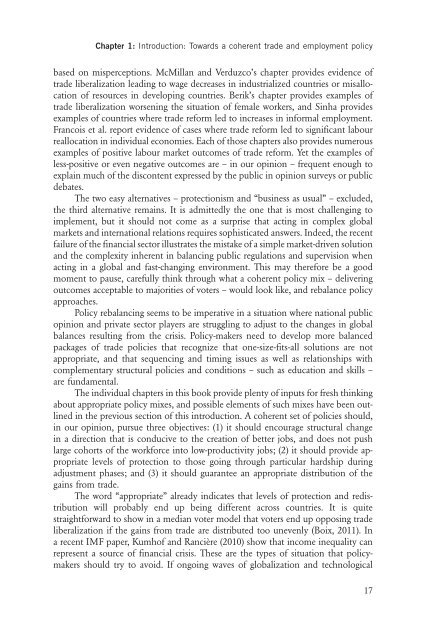Trade and Employment From Myths to Facts - International Labour ...
Trade and Employment From Myths to Facts - International Labour ...
Trade and Employment From Myths to Facts - International Labour ...
Create successful ePaper yourself
Turn your PDF publications into a flip-book with our unique Google optimized e-Paper software.
Chapter 1: Introduction: Towards a coherent trade <strong>and</strong> employment policy<br />
based on misperceptions. McMillan <strong>and</strong> Verduzco’s chapter provides evidence of<br />
trade liberalization leading <strong>to</strong> wage decreases in industrialized countries or misallocation<br />
of resources in developing countries. Berik’s chapter provides examples of<br />
trade liberalization worsening the situation of female workers, <strong>and</strong> Sinha provides<br />
examples of countries where trade reform led <strong>to</strong> increases in informal employment.<br />
Francois et al. report evidence of cases where trade reform led <strong>to</strong> significant labour<br />
reallocation in individual economies. Each of those chapters also provides numerous<br />
examples of positive labour market outcomes of trade reform. Yet the examples of<br />
less-positive or even negative outcomes are – in our opinion – frequent enough <strong>to</strong><br />
explain much of the discontent expressed by the public in opinion surveys or public<br />
debates.<br />
The two easy alternatives – protectionism <strong>and</strong> “business as usual” – excluded,<br />
the third alternative remains. It is admittedly the one that is most challenging <strong>to</strong><br />
implement, but it should not come as a surprise that acting in complex global<br />
markets <strong>and</strong> international relations requires sophisticated answers. Indeed, the recent<br />
failure of the financial sec<strong>to</strong>r illustrates the mistake of a simple market-driven solution<br />
<strong>and</strong> the complexity inherent in balancing public regulations <strong>and</strong> supervision when<br />
acting in a global <strong>and</strong> fast-changing environment. This may therefore be a good<br />
moment <strong>to</strong> pause, carefully think through what a coherent policy mix – delivering<br />
outcomes acceptable <strong>to</strong> majorities of voters – would look like, <strong>and</strong> rebalance policy<br />
approaches.<br />
Policy rebalancing seems <strong>to</strong> be imperative in a situation where national public<br />
opinion <strong>and</strong> private sec<strong>to</strong>r players are struggling <strong>to</strong> adjust <strong>to</strong> the changes in global<br />
balances resulting from the crisis. Policy-makers need <strong>to</strong> develop more balanced<br />
packages of trade policies that recognize that one-size-fits-all solutions are not<br />
appropriate, <strong>and</strong> that sequencing <strong>and</strong> timing issues as well as relationships with<br />
complementary structural policies <strong>and</strong> conditions – such as education <strong>and</strong> skills –<br />
are fundamental.<br />
The individual chapters in this book provide plenty of inputs for fresh thinking<br />
about appropriate policy mixes, <strong>and</strong> possible elements of such mixes have been outlined<br />
in the previous section of this introduction. A coherent set of policies should,<br />
in our opinion, pursue three objectives: (1) it should encourage structural change<br />
in a direction that is conducive <strong>to</strong> the creation of better jobs, <strong>and</strong> does not push<br />
large cohorts of the workforce in<strong>to</strong> low-productivity jobs; (2) it should provide appropriate<br />
levels of protection <strong>to</strong> those going through particular hardship during<br />
adjustment phases; <strong>and</strong> (3) it should guarantee an appropriate distribution of the<br />
gains from trade.<br />
The word “appropriate” already indicates that levels of protection <strong>and</strong> redistribution<br />
will probably end up being different across countries. It is quite<br />
straightforward <strong>to</strong> show in a median voter model that voters end up opposing trade<br />
liberalization if the gains from trade are distributed <strong>to</strong>o unevenly (Boix, 2011). In<br />
a recent IMF paper, Kumhof <strong>and</strong> Rancière (2010) show that income inequality can<br />
represent a source of financial crisis. These are the types of situation that policymakers<br />
should try <strong>to</strong> avoid. If ongoing waves of globalization <strong>and</strong> technological<br />
17

















